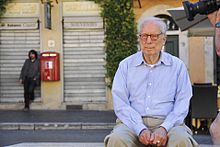Robert Venturi
American architect (1925-2018)
Robert Charles Venturi (June 25, 1925 – September 18, 2018) was a Philadelphia-based architect who worked under Eero Saarinen and Louis Kahn before forming his own firm with John Rauch.

| This article about an architect is a stub. You can help out with Wikiquote by expanding it! |
Quotes
edit- Less is a bore.
- A parody of Mies van der Rohe's dictum "Less is more".
- As quoted in Karsten Harries, The Ethical Function of Architecture, 1998, p. 8.
Complexity and Contradiction in Architecture (1966)
edit- Main Street is almost alright.
- Perhaps it is the fate of all theorists to view the ripples from their works with mixed feelings. I have sometimes felt more comfortable with my critics than with those who have agreed with me. The latter have often misapplied or exaggerated the ideas and methods of this book to the point of parody. Some have said the ideas are fine but don't go far enough. But most of the thought here was intended to be suggestive rather than dogmatic, and the method of historical analogy can be taken only so far in architectural criticism.
- Note to the Second Edition of Complexity and Contradiction in Architecture (1977)
- I like complexity and contradiction in architecture. I do not like the incoherence or arbitrariness of incompetent architecture nor the precious intricacies of picturesqueness or expressionism.
- 1. Nonstraightfoward Architecture: A Gentle Manifesto
- But architecture is necessarily complex and contradictory in its very inclusion of the traditional Vitruvian elements of commodity, firmness, and delight. And today the wants of program, structure, mechanical equipment, and expression, even in single buildings in simple contexts, are diverse and conflicting in ways previously unimaginable.
- 1. Nonstraightfoward Architecture: A Gentle Manifesto
- I am for messy vitality over obvious unity.
- I am for richness of meaning rather than clarity of meaning; for the implicit function as well as the explicit function.
- 1. Nonstraightfoward Architecture: A Gentle Manifesto
- Orthodox Modern architects have tended to recognize complexity insufficiently or inconsistently. In their attempt to break with tradition and start all over again, they idealized the primitive and elementary at the expense of the diverse and the sophisticated.
- 2. Complexity and Contradiction vs. Simplification or Picturesqueness
- Rationalizations for simplification are still current, however, though subtler than the early arguments.
- 2. Complexity and Contradiction vs. Simplification or Picturesqueness
- Nor does complexity deny the valid simplification which is part of the process of analysis, and even a method of achieving complex architecture itself.
- 2. Complexity and Contradiction vs. Simplification or Picturesqueness
- The calculated ambiguity of expression is based on the confusion of experience as reflected in the architectural program.
- 3. Ambiguity
- The double meanings inherent in the phenomenon both-and can involve metamorphosis as well as contradiction. I have described how the omni-directional spire of the tower of Christ Church, Spitalfields, evolves into a directional pavilion at its base, but a perceptual rather than a formal kind of change in meaning is possible. In equivocal relationships one contradictory meaning usually dominates another, but in complex compositions the relationship is not always constant. This is especially true as the observer moves through or around a building, and by extension through a city: at one moment one meaning can be perceived as dominant; at another moment a different meaning seems paramount.
- 4. Contradictory Levels: The Phenomenon of "Both-And" in Architecture
- The essential purpose of the interiors of buildings is to enclose rather than direct space, and to separate the inside from the outside
- 9. The Inside and the Outside
- Architecture as the wall between the inside and the outside becomes the spatial record of this resolution and its drama. And by recognizing the difference between the inside and the outside, architecture opens the door once again to an urbanistic point of view.
- 9. The Inside and the Outside